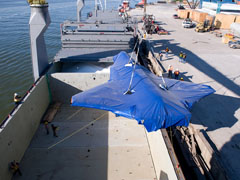
| F-35 'AG-1' Arrives
in the United Kingdom for Static Testing |
|
|
4/27/2009 - FORT WORTH, TX -- After a three-week ocean voyage, a static-test version of the Lockheed Martin F-35 Lightning II, also known as the Joint Strike Fighter, has arrived in the United Kingdom. The F-35A conventional takeoff and landing (CTOL) variant aircraft, called AG-1, will undergo testing in the Structural and Dynamic Test facility at BAE Systems’ site in Brough, East Yorkshire, England. Mick Ord, BAE Systems' managing director of the F-35 Lightning II business said, "This is another major milestone in the F-35 program and we’re delighted to take delivery of the full-scale static testing airframe. BAE Systems is a principal subcontractor to Lockheed Martin on the F-35 program and brings military aircraft expertise that is critical to the F-35 Lightning II airframe and systems. We lead on several work share areas, of which structural testing is one." AG-1 began its travels on March 27 at Lockheed Martin’s Fort Worth, Tex., plant. It was shipped overland to the Texas coast, where it was placed aboard a U.K.-bound cargo ship. AG-1 is one of six static test airframes constructed for the System Development and Demonstration phase of the F-35 Lightning II program, which is developing and validating all of the aircraft’s systems and manufacturing techniques. Another 13 F-35s are dedicated to flight testing. "The work BAE Systems is performing on AG-1 highlights just one of the United Kingdom’s many indigenous industrial capabilities that this program relies upon," said Tom Burbage, Lockheed Martin executive vice president and general manager of F-35 Program Integration. "We are conducting the largest-ever test program for a fighter, and the BAE Systems structural test facilities expand our bandwidth and help us maintain our schedule." Ord added, "BAE Systems is responsible for carrying out a large percentage of the structural and fatigue testing required to qualify all three of the F-35 variants. Some testing has been carried out on smaller components, but this will be among the first of the full airframe tests to be carried out." The Structural and Dynamic Test Facility at Brough is BAE Systems' center of excellence for structural testing, responsible for providing evidence that airframes meet the design requirements for structural strength and durability. The F-35 airframe will be connected to a highly complex test rig in which 165 hydraulic actuators will replicate the loads the aircraft would see in flight. The data from the test will be captured by 4,000 sensors bonded to the airframe. The test rig itself weighs around 365 tons and has approximately 53 miles (85km) of wiring spread around it to connect all the systems and sensors. The computing power available to control the load applications is roughly the equivalent of 25 high-specification personal computers. Testing is planned to begin in late July and will take about 15 months, certifying the strength of the airframe and its components and contributing to the aircraft’s flight envelope expansion requirements. Upon completion of its static testing program, AG-1 will be shipped back to the U.S. The F-35 is being built in three variants: conventional takeoff and landing, short takeoff/ vertical landing (STOVL) and carrier variant (CV). CTOL and CV durability airframe tests will also be undertaken at BAE Systems Brough site. Static testing of other F-35 airframes is under way at Lockheed Martin’s Fort Worth facility. In March, the U.K. Ministry of Defence announced it intends to order three instrumented STOVL F-35 Lightning II test aircraft and associated support equipment for Operational Test and Evaluation purposes. Background The F-35 airframe, AG-1, departed Lockheed Martin’s site at Fort Worth, Texas, on April 5, crossing the Atlantic by ship before arriving at the port of Hull on April 24. The airframe was transferred by barge up the river Humber, and lifted by crane onto BAE Systems' Brough site on the morning of April 25. The airframe was transported with wings and canopy installed to the main fuselage, and was shrink-wrapped to provide protection against the elements. The resulting shipment was 51 feet long, 35 feet wide and 13.5 feet high, and weighed some 22 tons. The Structural and Dynamic Test Facility has been performing to the highest standards for over 50 years. The Brough facility is a modern, purpose designed complex, comprising four large test halls, development laboratories and supporting infrastructure. Currently also undergoing tests in the Structural and Dynamic Test Facility are Nimrod MRA4, Hawk and Typhoon airframes. Source: Lockheed Press Release |
| |
